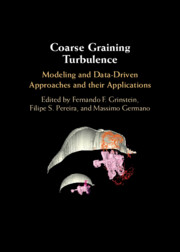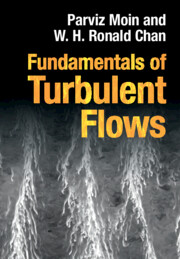Refine search
Actions for selected content:
8126 results in Fluid dynamics and solid mechanics
1 - Numerical Simulations and Coarse-Graining
- from Part I - Paradigms and Tools
-
-
- Book:
- Coarse Graining Turbulence
- Published online:
- 31 January 2025
- Print publication:
- 06 February 2025, pp 5-47
-
- Chapter
- Export citation
Abbreviations
-
- Book:
- Coarse Graining Turbulence
- Published online:
- 31 January 2025
- Print publication:
- 06 February 2025, pp 559-563
-
- Chapter
- Export citation
Index
-
- Book:
- Coarse Graining Turbulence
- Published online:
- 31 January 2025
- Print publication:
- 06 February 2025, pp 564-566
-
- Chapter
- Export citation
6 - Coarse-Graining Turbulence Using the Mori–Zwanzig Formalism
- from Part I - Paradigms and Tools
-
-
- Book:
- Coarse Graining Turbulence
- Published online:
- 31 January 2025
- Print publication:
- 06 February 2025, pp 177-201
-
- Chapter
- Export citation

Coarse Graining Turbulence
- Modeling and Data-Driven Approaches and their Applications
-
- Published online:
- 31 January 2025
- Print publication:
- 06 February 2025
EARLY WARNING PREDICTION WITH AUTOMATIC LABELLING IN EPILEPSY PATIENTS
- Part of
-
- Journal:
- The ANZIAM Journal / Volume 67 / 2025
- Published online by Cambridge University Press:
- 27 January 2025, e4
-
- Article
- Export citation
NONLINEAR MODULATION OF RANDOM WAVE SPECTRA FOR SURFACE-GRAVITY WAVES WITH LINEAR SHEAR CURRENTS
- Part of
-
- Journal:
- The ANZIAM Journal / Volume 66 / Issue 4 / October 2024
- Published online by Cambridge University Press:
- 10 January 2025, pp. 222-237
-
- Article
- Export citation

Fundamentals of Turbulent Flows
-
- Published online:
- 09 January 2025
- Print publication:
- 12 December 2024
-
- Textbook
- Export citation
OPTIMAL CONTROL PROBLEMS GOVERNED BY MARGUERRE–VON KÁRMÁN EQUATIONS
- Part of
-
- Journal:
- The ANZIAM Journal / Volume 67 / 2025
- Published online by Cambridge University Press:
- 01 January 2025, e38
-
- Article
- Export citation
DISSIPATION OF WAVE ENERGY AND MITIGATION OF WAVE FORCE BY MULTIPLE FLEXIBLE POROUS PLATES
-
- Journal:
- The ANZIAM Journal / Volume 66 / Issue 4 / October 2024
- Published online by Cambridge University Press:
- 26 December 2024, pp. 258-284
-
- Article
- Export citation
8 - Transition to turbulence
- from Part 1 - Fundamentals
-
- Book:
- Hydrodynamic Instabilities and Turbulence
- Published online:
- 27 June 2024
- Print publication:
- 19 December 2024, pp 149-158
-
- Chapter
- Export citation
5 - Global features from the lens of integrated mixingmeasurements
- from Part 1 - Fundamentals
-
- Book:
- Hydrodynamic Instabilities and Turbulence
- Published online:
- 27 June 2024
- Print publication:
- 19 December 2024, pp 91-110
-
- Chapter
- Export citation
Part 1 - Fundamentals
-
- Book:
- Hydrodynamic Instabilities and Turbulence
- Published online:
- 27 June 2024
- Print publication:
- 19 December 2024, pp 1-2
-
- Chapter
- Export citation
9 - Influence of initial conditions
- from Part 2 - Hydrodynamics of Complex Flows
-
- Book:
- Hydrodynamic Instabilities and Turbulence
- Published online:
- 27 June 2024
- Print publication:
- 19 December 2024, pp 161-182
-
- Chapter
- Export citation
3 - The nonlinear stage for a singlemode
- from Part 1 - Fundamentals
-
- Book:
- Hydrodynamic Instabilities and Turbulence
- Published online:
- 27 June 2024
- Print publication:
- 19 December 2024, pp 39-65
-
- Chapter
- Export citation
11 - Rotation and time-dependent acceleration
- from Part 2 - Hydrodynamics of Complex Flows
-
- Book:
- Hydrodynamic Instabilities and Turbulence
- Published online:
- 27 June 2024
- Print publication:
- 19 December 2024, pp 214-229
-
- Chapter
- Export citation
23 - Numerical simulations of mixing
- from Part 3 - From the Microscopic to Cosmic Scales
-
- Book:
- Hydrodynamic Instabilities and Turbulence
- Published online:
- 27 June 2024
- Print publication:
- 19 December 2024, pp 477-487
-
- Chapter
- Export citation
17 - Magnetohydrodynamic fluid instabilities
- from Part 2 - Hydrodynamics of Complex Flows
-
- Book:
- Hydrodynamic Instabilities and Turbulence
- Published online:
- 27 June 2024
- Print publication:
- 19 December 2024, pp 339-356
-
- Chapter
- Export citation
14 - Combined instabilities
- from Part 2 - Hydrodynamics of Complex Flows
-
- Book:
- Hydrodynamic Instabilities and Turbulence
- Published online:
- 27 June 2024
- Print publication:
- 19 December 2024, pp 277-285
-
- Chapter
- Export citation
6 - Internal dynamics from the lens of statistical mixingmeasurements
- from Part 1 - Fundamentals
-
- Book:
- Hydrodynamic Instabilities and Turbulence
- Published online:
- 27 June 2024
- Print publication:
- 19 December 2024, pp 111-134
-
- Chapter
- Export citation
